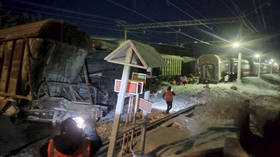Revenge of the Chinese ‘spy balloon’: The US takes the scandal global and turns it into a tool

After the outburst of paranoia triggered by the so-called ‘Chinese Spy Balloon’, the US has now reportedly briefed the diplomats of 40 countries about the supposed threat.
Washington has apparently sent American missions around the world information about the incident and presented to foreign diplomats gathered in Beijing information to demonstrate that it was indeed an espionage aircraft, and not a weather-monitoring balloon as China claims.
In addition to the domestic political motivations for Washington to whip up a frenzy about the Chinese balloon (covered here), we now see the US deliberately weaponizing the story to attack China on a global scale, aiming to instill greater fear, suspicion and paranoia of Beijing worldwide. The incident itself might be nothing more than hot air, but Washington is willing to gaslight its allies and “partners” into greater alignment with American goals and preferences.
The American foreign policy machine is a master of a process known as ‘manufacturing consent’, the term famously coined by Noam Chomsky and Edward S. Herman. The US uses an array of aligned think tanks and cherry-picked experts, as well as a monopoly over information and press access, in order to perfectly craft a narrative which promotes their goals and preferences. Simply speaking, the topics, areas of interest and points of view which the US government focuses on are given funding (often from government departments), press access and regular airtime. Those it does not care for are simply ignored.
As a key example of how this works: Earlier this week, the Washington Post ran a story that cited unnamed US officials to confirm the Chinese balloon was indeed used by Beijing’s military for spying and was part of a wider aerial surveillance effort. Not only is this a direct official-to-media report, but no evidence or facts were given, neither was any possible agenda behind the story highlighted or scrutinized, nor any ‘alternative’ point of view presented. Of course, these are beyond the scope of a simple news story – and we don’t get anything other than this news story, sourced from US officials, speaking to the media on condition of anonymity but most likely with the direction of their superiors. This is how the US government shapes the narrative and manufactures consent through the media.
So what’s the agenda behind the US raising the ‘spy balloon’ alarm internationally? It’s one thing to make it a scandal at home, trading some political points over who is the most hard-line on China, but to publicize it internationally like that, there must be a bigger goal behind it. By claiming that the balloon was being used for military and espionage purposes, and therefore constitutes a ‘national security threat’, the US is clearly eyeing up an opportunity to impose new sanctions against Chinese firms.
It has been a running theme of US sanctions against China to blacklist a company, either from receiving US technology exports, or from US investment, by claiming that it is owned or operated on behalf of the Chinese military, even when it isn’t. This has been a key part of Washington’s growing technology war against Beijing. These assumptions are made on insinuations and ‘guilt by association’ logic, rather than clear-cut proof. Therefore, the US could be preparing to blacklist the companies involved in constructing the balloon, claiming they are a military threat.
In addition to that, it should be noted that the US is also trying to push G7 to collectively sanction China for “supporting” the Russian offensive in Ukraine, which would also involve blacklisting Chinese firms. As this requires consensus, Washington is looking to get more partners on its side, and creating a political capital of mass paranoia against China is one way to do it. History shows that if the US cannot get allies to comply with a given foreign policy course of action, its response is to deliberately escalate tensions until they do. We have seen this many times in its approach to China and Russia.
Given this, the conclusion is that the US is manufacturing outrage over the Chinese balloon in order to manipulate international discourse to procure support for its foreign policy objectives. This is not just a domestic policy squabble, and not at all a matter of national security; the US is actively aiming to amplify the threat of the balloon to leverage its allies into following suit with anti-China objectives. In addition, it is clear from circumstantial evidence that the Biden administration is also eyeing up new sanctions on China, and what better opportunity is there to do so than a hyper-dramatic incident like this? The US always, always exaggerates threats to shape its agenda, at home and abroad.
The statements, views and opinions expressed in this column are solely those of the author and do not necessarily represent those of RT.














